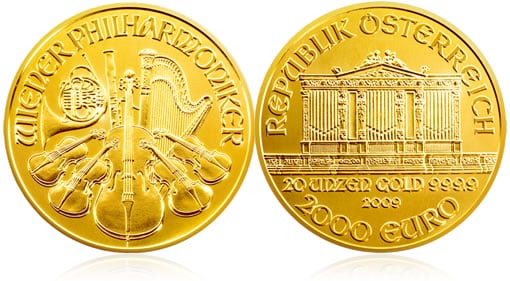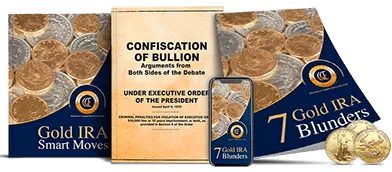Table of Contents
Austrian Philharmonic Gold Coin

Have you ever wondered what gold coins from Austria look like? Put your curiosity at ease, as we are here to tell you all about the famous Austrian Philharmonic Gold Coin. This coin has been gaining worldwide attention in recent years due to its purity and exquisite beauty – making it one of the most sought-after gold investments on the market.
Whether you’re interested in buying them, know someone who wants a special gift, or are just curious, this blog post will provide detailed information regarding this unique and desirable coin.
What Is the History of the Austrian Gold Philharmonic Coin
The Austrian Gold Philharmonic was first issued in 1989 by the Austrian Mint to commemorate the Vienna Philharmonic Orchestra. Since then, it has become one of the most popular gold coins due to its exquisite beauty and purity. For more than 30 years, this bullion coin has been highly sought after by investors and collectors worldwide.
The coin has undergone a few changes since the first minting. The only difference between coins from before 2002 and afterward is their denomination; pre-2002 coins were listed with a face value of 2,000 schillings, while post-2002 coins are denominated in euros, at 100 euros per piece. This makes the 1-ounce Austrian Gold Philharmonic one of the few gold coins in Europe to be produced on a mass scale.
In addition, the Austrian Gold Philharmonic is unique from other gold coins in that it offers smaller fractional sizes suitable for smaller investments. These fractional sizes come in 1/10th and 1/25th ounce pieces with .9999 fine gold. This makes collecting the coin affordable even for people with limited budgets.
Designs of the Austrian Philharmonic Gold Coin
The Designs of the Austrian Philharmonic Gold Coin are highly sought after and admired for their impressive beauty and detail. The chief engraver, Thomas Pesendorfer, designed a coin that reflects Austrians’ cultural pride in their beloved orchestra.
On the obverse side is an image of the Musikverein pipe organ inside Vienna’s Golden Hall. The coin also features German engravings that read “Republik Oesterreich,” “Unze Gold 9999,” and the coin’s weight, face value, and year of issue.
On the reverse side are various musical instruments used by members of the Vienna Philharmonic. This includes a large cello in the center with two violins on either side and a harp, horn, and bassoon in the background.
Engravings on this face are also in German and read “Wiener Philharmoniker.” The Austrian Mint has used these designs since 1989, which has made them highly collectible amongst investors and collectors alike.
Details of the Austrian Gold Philharmonic Coin
The Austrian Gold Philharmonic is a highly desirable gold coin gaining worldwide attention due to its unique design, purity, and beauty. The coins are issued by the Austrian Mint with .9999 fine gold content, making them one of the most pure and valuable coins available on the market. Originally introduced in 1989, these coins have face value in either Austrian Shillings or Euros.
The Austrian Gold Philharmonics coins come in several denominations, including a 1 oz coin with a face value of either 2,000 Schillings (pre-2002) or 100 euros (post-2002), a 1/2oz coin with a face value of either 1000 Schillings or 50 euros, as well as smaller fractional sizes of 1/4oz, 1/10oz, and 1/25oz with face values of 500 Schillings, 200 Schillings or 25 euros, 10 euros and 4 euros respectively.
Variations of the Austrian Gold Philharmonic Coin
In addition to the standard issue coins, the Austrian Mint has released several coin variations throughout its 30-year history. These include special collector editions such as “Big Phil” and 20 oz coins and fractional sizes such as 1/10th and 1/25th ounce pieces.
Big Phil Collector Edition (2004)
In 2004, the Austrian Mint released a special collector’s edition of the Gold Philharmonic coin known as “Big Phil” to commemorate its 15th anniversary. The coin was struck with an impressive 1,000 Troy ounces of .9999 pure gold and had a face value of €100,000. Only 15 coins were issued, making them extremely rare and desirable among collectors.
20 Oz Austrian Gold Philharmonic (2009)
In 2009, the Austrian Mint released a 20 oz Gold Philharmonic to mark the coin’s 20th anniversary. The coins were struck with an impressive 20 Troy oz of .9999 pure gold with a face value of €14,000. Three batches of 2009 coins were issued to celebrate the anniversary – one for each European, American, and Japanese market.
1/25th Oz Austrian Gold Philharmonic (2014)
The 1/25th oz Austrian Gold Philharmonic coin was introduced in 2014, initially intended as a 25th Anniversary coin. The coins are struck with 1/25 Troy oz of .9999 pure gold and a face value of €4.
Despite being originally intended as a limited edition coin, the Austrian Mint continued production of these fractional-size coins due to their increasing popularity among investors and collectors.
These unique variations of the Austrian Gold Philharmonic coin are highly desirable among investors and collectors due to their rarity, purity, and beauty. Whether you’re looking for a unique gift or investment opportunity, these coins offer a great way to appreciate the intricate design of this iconic gold coin.
What are the Benefits of Austrian Philharmonic Gold Coins
Austrian Philharmonic coins are some of the most desirable gold investments on the market. These coins offer investors several attractive benefits, making them an appealing choice for those looking to add gold to their portfolios.
High-Quality Gold Content
The Austrian Philharmonic is unique among gold coins in that it is composed of .9999 fine gold, making it one of the purest gold coins on the market. This purity level ensures investors get more bang when investing in gold.
Guaranteed by the Austrian Government
Austrian Philharmonic Gold Coins are official legal tender issued by the Austrian government, and as such, they are backed by the full faith and credit of the Austrian government. This provides additional peace of mind for investors, as the coins are guaranteed to be authentic and of a certain quality.
Tax-Free in U.S.
Investors in the United States will be pleased to know that Austrian Philharmonic Gold Coins are exempt from sales tax, which can add up over time if you’re making regular purchases of gold.
Competitive Pricing and Premiums
One of the best aspects of Austrian Philharmonic coins is their competitive pricing structure. The coins typically carry low premiums, meaning that investors can get more gold for their money than with other coins on the market.
Portability
The small size of these coins makes them extremely easy to transport and store- making them a great option for those seeking an internationally liquid form of financial insurance.
How to Buy Austrian Philharmonic Gold Coins
If you want to buy Austrian Philharmonic Gold Coins, several options are available for investors. The most popular option is purchasing them through a reputable online dealer or coin shop.
Online dealers typically offer coins and bars of .9999 fine gold, so it’s easy to find your desired product. It would help if you always looked for established companies with a proven track record of providing quality products and services.
In addition to online dealers, you can also buy philharmonic gold coins from many banks worldwide. These coins are often available in different denominations, so it’s important to ask your bank which sizes they offer before purchasing.
Banks generally charge higher premiums than online dealers, but they offer the convenience of being able to purchase your coins in person.
Another option for buying Austrian Philharmonic Gold Coins is through auctions or eBay. These sites can be a great way to find rare coins, but it’s important to research before bidding on any item. You should always check that the seller is reputable and has a good rating from previous buyers.
Finally, you can purchase Austrian Philharmonic Gold Coins directly from the Austrian Mint. The coins are available in sizes ranging from 1/25oz to 1 Troy oz and can be bought individually or in tubes of 20 coins. Purchasing coins directly from the Mint is an excellent option for those looking for high-quality coins without a premium.
Should Investors Buy Austrian Philharmonic Coins As An Investment
Austrian Philharmonic Gold coins are some of the world’s most popular gold bullion coins, renowned for their high-quality content and beautiful design.
These coins offer a great way for investors to diversify their portfolios with precious metals while offering a variety of benefits, including tax-free purchases in the U.S., competitive pricing and premiums, portability, and guaranteed authenticity and quality.
Whether seeking to buy coins to invest or looking for an impressively designed gift, Austrian Philharmonic Gold Coins are a great option.
FAQs
What is the Austrian Gold Philharmonic?
The Austrian Gold Philharmonic is a gold bullion coin produced by the Austrian Mint. It is one of the best-selling gold coins in Europe and features an impressive design of Vienna’s famous orchestra.
What size are the Philharmonic Gold Coins?
The Philharmonic Gold Coins come in various sizes ranging from 1/25th to 1 Troy oz.
What is the Vienna Philharmonic Coin?
The Vienna Philharmonic Coin is a one-ounce platinum coin produced by the Austrian Mint. It features an image of the Musikverein Orchestra on its obverse and a design of instruments on its reverse.
How long has the Austrian Gold Philharmonic coin remained popular?
The Austrian Gold Philharmonic coin remains a popular gold investment since its introduction in 1989 and continues to be best best-selling gold coin in Europe.
Can I buy silver coins from the Vienna Philharmonic Coin series?
Yes, the Vienna Philharmonic coins are also available in silver coin. They come in denominations of 1/2oz, 1/4 oz and 1/10oz.
How can I buy a one-ounce coin from the Vienna Philharmonic series?
You can purchase a one-ounce coin from the gold Vienna Philharmonic series through a reputable online dealer or coin shop. You can also purchase them from banks and directly from the Austrian Mint.
What benefits do I get when buying a Vienna Philharmonic coin?
When you buy a Vienna Philharmonic coin, you will receive the highest quality coins since they are composed of .9999 fine gold. Knowing that the Austrian government backs your investment, you will also have peace of mind. Additionally, investors in the U.S. will benefit from tax-free purchases of these coins.
What makes Austrian Gold Philharmonic Coins a great investment option?
Austrian Philharmonic gold coins are an excellent investment option due to their competitive pricing structure, low premiums, portability, and guaranteed authenticity and quality. They also offer investors the opportunity to diversify their portfolios with precious metals tax-free in the U.S. Their beautiful design makes them a perfect gift or collectible item.
Conclusion
Austrian Philharmonic Gold Coin is one of the most popular gold investments on the market. With its .9999 fine gold content, competitive pricing and low premiums, portability, and tax-free purchase options in the U.S., this exquisite coin is an ideal way to diversify your portfolio with precious metals.
Austrian Philharmonic Gold Coins are the perfect choice if you’re looking for a gift, an addition to your collection, or a sound investment option. These coins will surely make a great impression with their beautiful design and guaranteed quality.

Avoid These 10 Gold IRA Scams.

DEALERS USE ON YOU







